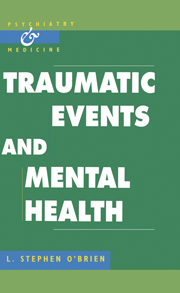Book contents
- Frontmatter
- Contents
- Foreword
- 1 Introduction and historical perspective
- 2 Normal reactions to trauma
- 3 Epidemiology of post-traumatic stress disorder and post-traumatic illness
- 4 Aetiology and predisposing factors
- 5 What constitutes a stressor?
- 6 Post-traumatic illness other than post-traumatic stress disorder
- 7 Diagnosis and assessment
- 8 Management and outcome of post-traumatic illness
- 9 Medicolegal aspects of post-traumatic illness
- 10 Prevention of post-traumatic illness
- 11 The way ahead – whither now?
- Index
10 - Prevention of post-traumatic illness
Published online by Cambridge University Press: 05 May 2010
- Frontmatter
- Contents
- Foreword
- 1 Introduction and historical perspective
- 2 Normal reactions to trauma
- 3 Epidemiology of post-traumatic stress disorder and post-traumatic illness
- 4 Aetiology and predisposing factors
- 5 What constitutes a stressor?
- 6 Post-traumatic illness other than post-traumatic stress disorder
- 7 Diagnosis and assessment
- 8 Management and outcome of post-traumatic illness
- 9 Medicolegal aspects of post-traumatic illness
- 10 Prevention of post-traumatic illness
- 11 The way ahead – whither now?
- Index
Summary
There is considerable interest in the prevention of PTI. Popular opinion and the involvement of the media mean that it has now become entirely routine, if not somehow mandatory, for officially sanctioned efforts to be put in place to prevent PTI. At the time of writing, the most recent example has perhaps been the tragic killing of children in a school in Dunblane. As usual, there were the immediate reports of the arrival of ‘trained counsellors’ to help the survivors and the bereaved to cope. In conversation recently researchers have commented upon the difficulties in conducting a controlled trial of counselling or psychological debriefing after disasters because of the reluctance of survivors to become part of the control groups. Everybody in the general population knows that disaster is followed by some form of counselling or intervention and they are wary about being left out. There is a widespread assumption that such intervention is at least helpful, if not essential.
However, as recently as 1994, Lundin has said ‘it is not quite clear that it is possible to prevent post traumatic stress disorder by means of early psychological support, counselling, or psychotherapeutic treatment’ (Lundin, 1994). However, despite this, he nevertheless expresses the view, which is no doubt held by many who work in the management or provision of health services, that there is a ‘basic human duty’ to try to do so.
- Type
- Chapter
- Information
- Traumatic Events and Mental Health , pp. 262 - 281Publisher: Cambridge University PressPrint publication year: 1998

